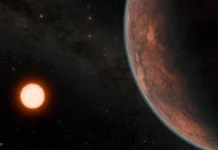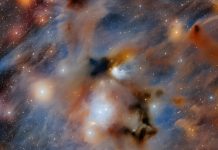
An international team of astronomers has discovered a new Earth-sized planet just 55 light-years away, orbiting an ultra-cool red dwarf star.
This planet, named SPECULOOS-3 b, is only the second Earth-sized planet found around this type of star.
SPECULOOS-3 b orbits its star in just 17 hours. The star is much cooler than our sun, over twice as cold, ten times less massive, and a hundred times less luminous.
Because of this, days and nights on SPECULOOS-3 b seem to last forever; the planet is likely tidally locked, meaning the same side, called the “dayside,” always faces the star, similar to how our moon always shows the same face to Earth.
The discovery, published in Nature Astronomy, was made by the SPECULOOS project.
This project is led by the University of Liège in Belgium, with contributions from the Universities of Birmingham, Cambridge, Bern, and the Massachusetts Institute of Technology (MIT). SPECULOOS stands for Search for Planets EClipsing ULtra-cOOl Stars.
The project uses a network of robotic telescopes worldwide to search for exoplanets orbiting ultra-cool dwarf stars.
Ultra-cool dwarf stars are very common, making up about 70% of the stars in our Milky Way galaxy. However, they are very faint and scattered, so scientists need to observe each star individually for several weeks to detect any planets passing in front of them, which is known as a transit.
“We designed SPECULOOS specifically to observe nearby ultracool dwarf stars in search of rocky planets that lend themselves well to detailed studies,” says Michaël Gillon, an astronomer at the University of Liège and lead author of the study.
“In 2017, our SPECULOOS prototype using the TRAPPIST telescope discovered the famous TRAPPIST-1 system, which has seven Earth-sized planets, several of which might be habitable. This was an excellent start.”
Most of the observations for this discovery were made by SPECULOOS telescopes in the Northern Hemisphere. However, researchers from the University of Birmingham also contributed observations from the SPECULOOS South Observatory in the Atacama Desert, Chile.
Amaury Triaud, a professor of Exoplanetology at the University of Birmingham, stated, “The discovery of SPECULOOS-3 b shows our worldwide network functions well and is ready to detect more rocky worlds orbiting very low-mass stars.
While ultra-cool dwarf stars are cooler and smaller than our sun, their lifespan is over a hundred times longer—around 100 billion years—and they are expected to be the last stars still shining in the universe.”
This long lifespan means these stars could offer opportunities for life to develop on their orbiting planets.
Usually, astronomical data is analyzed by algorithms that detect planetary candidates, which are then reviewed by scientists.
However, in this case, the SPECULOOS team manually reviewed the nightly data. Dr. Georgina Dransfield, a former Ph.D. student at the University of Birmingham and now a postdoctoral researcher there, noticed the planetary signal and alerted the team.
“The small size of ultra-cool dwarfs makes it easier to detect small planets. SPECULOOS-3 b is special because its stellar and planetary properties make it an optimal target for the James Webb Space Telescope (JWST),” says Dransfield. “JWST can provide information about the composition of the rocks that make up the planet’s surface.”
Next steps for the project may include follow-up observations by the JWST. These observations could offer important insights into the planet’s surface mineralogy and the potential for an atmosphere, providing more information about this intriguing new world.



